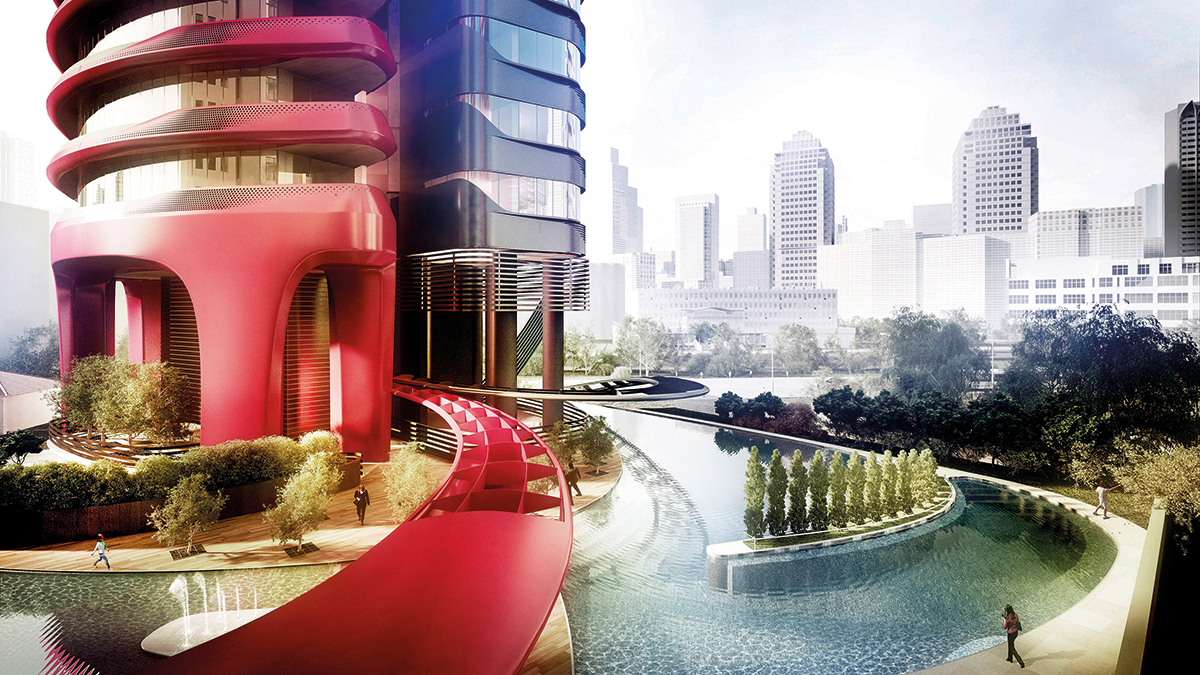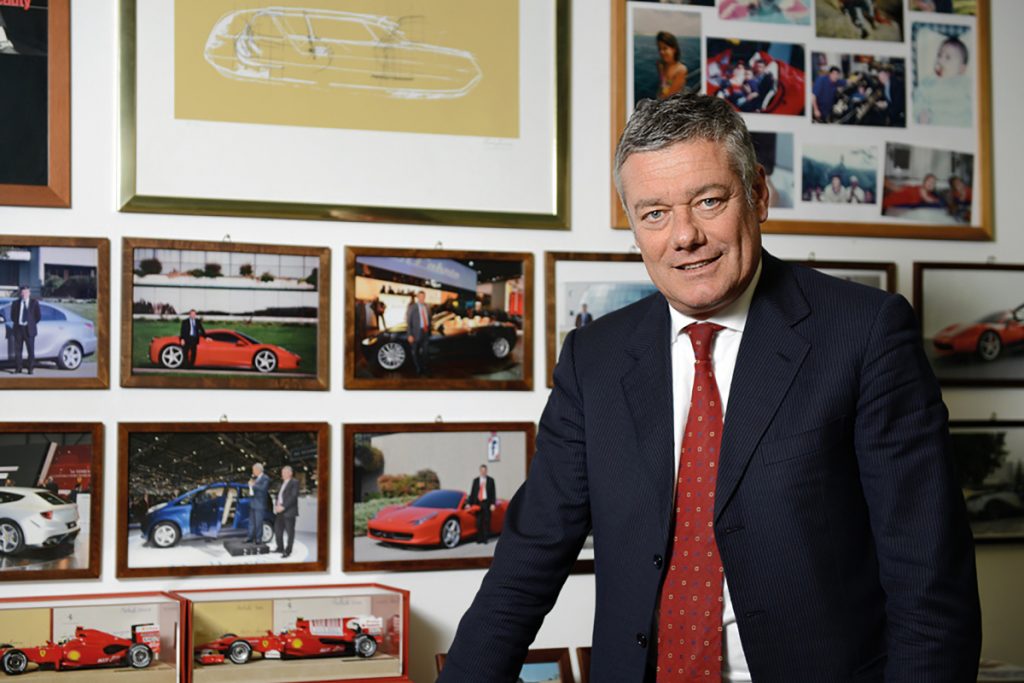There are no coincidences! Battista was nicknamed “Pinin” because he was the baby of the family. He survived the great wars (I and II) and forged a company whose name is synonymous with elegance, purity and quality. His son, Sergio carried the name to the top of the world despite the social crises facing him. Sergio’s cousin, Nino, was F1’s first world champion. Sergio’s sons, Andrea and Paolo battled mediocrity to safeguard and maintain the company’s status as the design and engineering icon of Planet Earth. It is a fascinating family story. Today, as fourth president of the monumental entrepreneurial giant, Paolo Pininfarina shares the values and commitments of their illustrious history.
F.1.M. : Pininfarina has a very intersting history. It is a survivor. Could you provide us with the wonderful story of its beginning ?
P.P. : Pininfarina spans 83 years of history. Ours is a story of survival; world wars and economic turndowns, all of it provided us with the impetus to continue our commitment to the world of design and engineering. We have suffered, but none of these have stunted our growth and momentum.
Through these 83 years, we have an ongoing generational continuity from father to son: we are the third generation, I am the 4th president. This continuity represents our values: integrity, single-mindedness, honesty, quality, the pursuit of beauty, and consistency. Therefore, the story continues with new images of success. The business obviously also follows the more general context, considering the fate of the market and the fates of the nationally and international economic situations. Pininfarina has fortunately always had an international vocation. My grandfather wanted to reach this goal in the 50s, with contracts with Peugeot, General Motors, Nissan, etc.; then my father advanced further on the international front; my brother even more; and I, myself, have continued to diversify. But we always remained a beacon of quality. The quality of the project, including that of the partners, and the product, are the reasons why we continue to be the recipients of countless international awards. Just a few days ago in Germany, we picked up the 1st and 2nd prizes of the Autonis Design Awards (awarded for the Ferrari-engineered ‘Sergio’ concept car and for BMW’s Pininfarina Gran Lusso coupe). It seems that there is no crisis for those whose motto is quality! The President of Ferrari proudly told me: “I saw that you won 1st prize!” “Great, I replied, but we also won 2nd!“
The Pininfarina family has had to battle many obstacles, and today I’m trying to fight the challenge of quality, while maintaining the rigors of keeping the bar high on excellence, with an emphasis on the company’s expertise and stylistic engineering. This is a brand that has a huge value aesthetic; is admired because of its history, but also has been fueled by the consistency of which I spoke of before.
F.1.M. : In many companies, there seems to be a lack of global vision. We often see thriving companies that are good, but they are so focused on one kind of product or service, at a time when, for historical or technical reasons, this service is required much less. These companies do not demonstrate sufficient elasticity or vision for change.
P.P. : Success is also a synonym of reliability, quality, and excellence. Last September we sponsored the Italian Golf Open, which was a huge success with the public, on a beautiful playing field. This was a project that took 9 months, which turned out to be absolutely beautiful, strictly Italian, and implemented with enthusiasm. I have to say that each moment carried with it the memory of my father and the Pininfarina name. A sponsorship, sporting the company’s dignity, but especially, its prestige. This brought to mind that there is also the Pininfarina that ennobles an initiative; in short, I spent a very nice weekend.
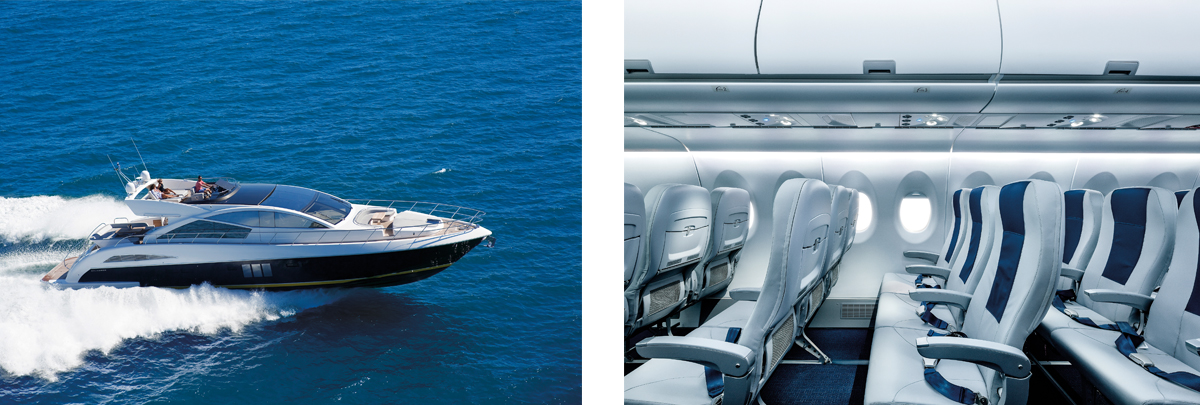
F.1.M. : Thus, you are a very Italian company…
P.P. : Born Italian, but international as a vocation.
F.1.M. : You now have a truly global structure, with offices in Europe, USA, Morocco, Germany and China. The latter is a country that does not always adhere to copyright regulations – especially in the context of design, which is not really one of their most widespread qualities.
P.P. : As I said, we connect a bit to history, and have always had an interest in Asia. My grandfather had it, my uncle Renzo, and my father during the 50s-60s (Nissan). We wanted to have a connection with Japan; the Honda in the 70s, then we had the Mitsubishi in the 90s, until we became a little exhausted in the sense that this Japanese wave had dried up in the automotive world. Of course, currently there is renewed interest because of prices and a certain kind of excellence that we maintain with Ferrari and BMW that intrigues them. But having said that, the Japanese wave is a bit slumped: very targeted with specialised consultation, and so on.
Then there was the Korean wave in the 90s and partnerships in cars and other products. The third wave is that of China. As these countries reach a certain type of industrial explosion, the market opens to the outside to study ideas, sometimes even to copy them (in China, more than other Asian markets). So we tried openness and flexibility. We began working with China in ‘96, and since then, we have in 16/17 years changed about 15 partners; we currently have 3. It is hard to retain them. Honestly, we want to keep China as an antenna in Asia. It is a learning process and we are present; we consult a lot, but we have to teach them our ability to create brand identity.
From there to say that you can stabilize such collaboration, or establish long-term relationships, I am prone to answer no. The economy is volcanic, and decisions and relationships constantly change.
There is a dynamic, but often this results in exasperation. Nonetheless, it is a market that has growth rates that exist nowhere else. So, why not be there? Remember, this is not really the core business of Pininfarina.
The core business of Pininfarini is in long-term relationships. With China, it is not how it works now; but how it will work in 2 or 3 years; we might have a long-term cooperation. Never say never!
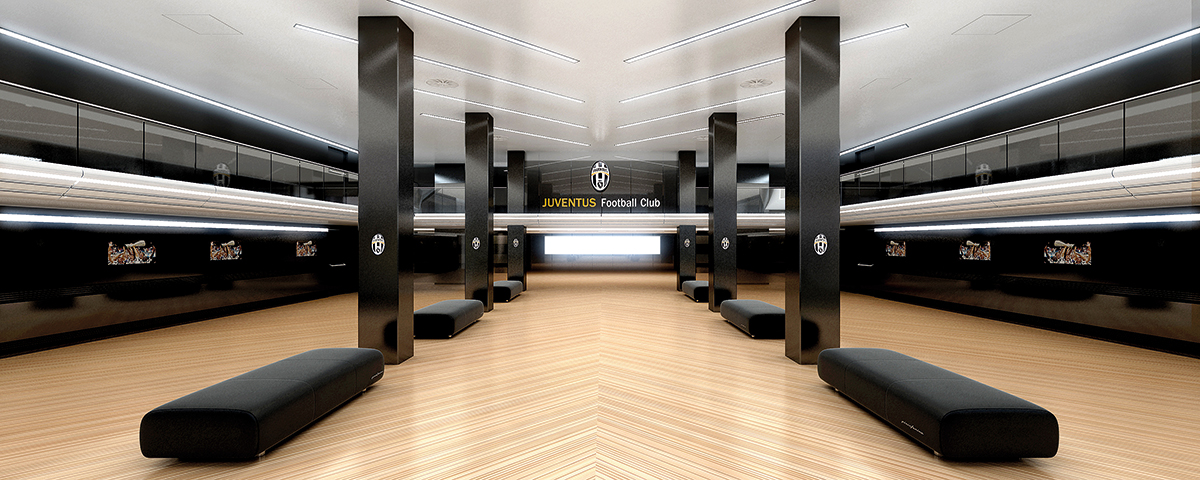
F.1.M. : Concerning activities, also your contracts in all other countries, maybe it would be better to move a little more towards the United States?
P.P. : In other countries, for the automotive market, I would say that there is Germany which my brother believed in during the early 90s, building engineering for acquisitions and also on the loyalty of BMW. In India, we have solid and mutually satisfying cooperation with Mahindra. We are always upholding the internationality of Pininfarina, because in Italy, our collaboration with the letter “C” is with Ferrari. Then we also have an important partnership with Bolloré in France in the field of electric cars.
As concerns our collaborations with non-automotive contracts, we have historical industrial design packages that include furnishings and industrial designs. Of these, we mention two: In Italy, Snaidero and Lavazza are very important designs, with a solid historical collaboration. But we have others more recent, and perhaps a little less known to the consumer which include sectors dealing with furniture : office , home , locks, alarm systems , electronics …
Abroad, we have recently consolidated our presence in the UK with the groups Whitbread and Pernod Ricard, thanks also to our Pininfarina in London show which was a huge and prestigious success for the Pininfarina brand. In France we have always had the collaboration in the design sector, including non-automotive contracts; especially Guerlain in the packaging industry. Outside Europe, Japan, Korea (electronics industry), then the United States, Asia, Singapore, and Hong Kong, making us fairly well distributed geographically . The strength of the Pininfarina brand is in fusing its business sectors: markets , products , and services.
I am flattered to be part of this community of designers and architects who are also involved in the urban setting of the city of the future.
F.1.M. : Exporting design equals exporting beauty. Could you say a few words on Beachwalk in Florida, on the skyscraper in Singapore, which are areas that one does not necessary associate with industrial design?
P.P. : We had a strategy. As we departed from accessories, we moved to decor: solid interest, collateral, and industrial design. If I design a car, I can design a coffee machine, a vending machine … then a cabinet … If I do the interior of a bus or an aircraft, or boat, I can also make the office interior, office furniture, kitchen furniture… After we did this, we moved to consolidating these designs and furniture design … it took 10 to 20 years … And indeed, during the last decade, the Torch for the 2006 Torino Winter Olympics was a special success that sealed the fate of Pininfarina as a global designer.
That being said, I moved ahead of myself. To further diversify the products or furnishings, as well as the integration of the furnishings in the interior was the new frontier, a new step. I must say that we started the office projects in 2004. But the big step that put our name on the market in this area, from the point of view of communication, was the interior design of the Juventus Stadium, which became our calling card in South America. The iconic stadium project represents a gigantic step for us on the architectural map of the world. Furthermore, in search of a new architectural language, I would say that the project “Ferra” in Singapore is truly a milestone, just like the Juventus Stadium; the Snaidero kitchen; the Lavazza coffee machine… in my opinion, we have found our own functional and emotional architectural identity.
We also made relevant efforts in Florida, that we have identified as our bridge for the United States, where there is great enthusiasm for the Made in Italy label. It’s a happening place and after 1100 Millecento Residences in Miami, came the consolidation of Beachwalk.
In Florida there is an important community, both Argentinian and Brazilian, and our links with this community are leading us to Latin America. This is something that we are pursuing, but it’s still a little early to see things even if something is already there. The Desarrollo Mor, a nautical infrastructure project in Argentina, is very important…
So we’re actually checking our third phase of consolidation and diversification which represents an extremely strong potential. When I started, we were involved in one interior design project a year; now we are doing a project of interior design each season of the year (both interior and exterior), and they’re also doubling in size. So it’s as if the activity has more than quadrupled.
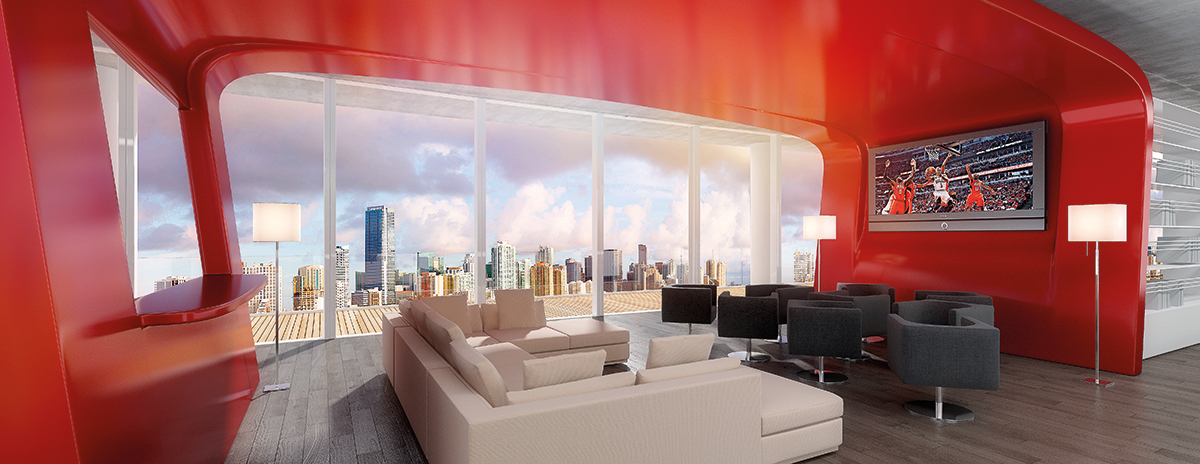
F.1.M. : You, quite rightly, as every business leader, give us a lot of figures that are important because they are the thermometer to understand how things are, but when you bring to completion these important projects, it seems larger than the satisfaction on just the entrepreneurial level. To have acquired an important contract, providing work for so many people…we get the humanistic picture: you give an impression of embellishing things, cities, neighborhoods… in keeping with the historical past. We could say you continue the activity of some of the greats of the past who have defined the city as we live today; that is the aesthetic aspect…
P.P. : You know, it does a company good to prosper: to receive something back, to be able to develop, invest, take risks, get back to the drawing board, design, etc. .. But there is also a way of having your say!
I, for one, am not a conservative, I am quite a proponent of building vertically. Actually, we are all supporters of this, except when we arrive in our own territory… It is clear that you don’t have to make it 3 feet from the Mole Antonelliana, but the world moves on. Time leaves its mark and Italy cannot afford to be left behind. When I go to Frankfurt, I see about 10 high-rise buildings; there are 8 in Milan and in Turin there will be 2 or 3. So I am flattered to be part of this community of designers and architects who are also involved in the urban setting of the city of the future. I just love it!
F.1.M. : I would like to see engineer Paolo Pininfarina taking a blank sheet of paper and a Carbon graphite pen, just designed for Visconti, and draw something for the Principality of Monaco. What do you think would be on that sheet of paper? Where could you see a possibility?
P.P. : I think that an interesting concept would be managing the boats on the ground, rather than on the sea. The quality of life in Monaco is directly tied to the marina where investments have been made for large boats. Much of the marina space is used for large boats, but I think there is always the desire to do more, to grow, to improve quality. Monaco is always at the forefront of things: it is like being in a laboratory on the Mediterranean. So I would like to consider the “TIFON” project, a sustainable system that allows working on boats directly on the ground, without increasing the surface of the marina. And it’s an intriguing project, because it includes Architecture, Interior Design, and the improvement of the quality of life of those working on boats.
Made in Italy – where is it going? I have to say that lately something nice has happened in Italy, which is the recovery of the Giglio Island misfortune through an advanced engineering project. I do not know all the details, but much of the prestige that we lost has been restored. Italy is the birthplace of artists, architects, creators, musicians and even a country of engineers. Let us not forget that Leonardo da Vinci was first and foremost an engineer. We have proven to the world that we are good engineers.
I think our image and destiny reside in the software, in the quality of our engineering reputation. It is a premium niche … What Italy is doing compared to others like in Maserati or Ferrari, as well as in design, creativity, fashion, etc. is great for our national position, even in high-tech engineering. Pininfarina is a company that is equally known worldwide for its creativity and also its engineering: this has always been an important component of our design identity.
I graduated in engineering and became a creative later on. My father taught me that with the greater focus on engineering, you could then go where your heart leads you: but the basics is engineering.
My father taught me that with the greater focus on engineering, you could then go where your heart leads you: but the basics is engineering.
F.1.M. : You first need to know how to hold the pen in your hand and then draw …
P.P. : If I had wanted to be a great salesman, I would have focused on the commercial side of things; but if one is more open to innovation, style, eventually the things that I was committed to, then you have to be closer to the product from the point of view of styling and creativity.
